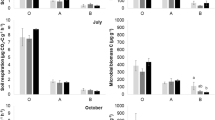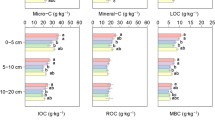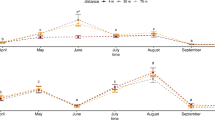Abstract
Labile C input to the soil can cause the priming effect (PE) that in turn changes the soil organic C (SOC) content. However, little information is available to predict the magnitude of the PE in different soils, especially under concurrent changes in nutrient inputs. We took advantage of a natural gradient in labile C input in the surroundings of wood ant nests in a temperate coniferous forest which arises through the long-term effects of wood ant foraging on the inputs of honeydew to soil. We collected soils from the surface mineral horizon (high-SOC content) (A horizon) and the subsoil mineral horizon (low-SOC content) (B horizon) at 4 m (low labile C input and higher SOC content) and 70 m (high labile C input and lower SOC content) from four nests. In a 6-month laboratory microcosm experiment, we monitored microbial activity and PE as affected by no nutrient addition (control) or fortnightly additions of labile C alone or in combination with N and/or P (C, CN, CP, CNP). Microbial activity and PE after C addition increased more at 70 m than at 4 m in the B horizon, that is, were higher with a lower SOC content. However, microbial activity and PE in the B horizon were not affected by additions of N and/or P with C. In the A horizon, microbial activity and PE were lower after combined CN addition but increased by combined CP addition relative to C addition alone. In conclusion, labile C inputs had a larger effect on decomposition and PE in low-SOC than high-SOC soils, whereas N and P inputs had greater effects in high-SOC soils than in low-SOC soils. This suggests that low-SOC soils such as those subjected to a high long-term labile C input or those from the subsoil mineral horizon might be more susceptible to increase microbial activity in relation to changes in labile C inputs but less susceptible in relation to changes in N and P inputs relative to high-SOC soils.


Similar content being viewed by others
Data availability
Not applicable.
Code availability
Not applicable.
References
Batjes NH (1997) A world data set of derived soil properties by FAO_UNESCO soil unit for global modelling. Soil Use Manag 13:9–16
Berg B, McClaugherty C (2008) Plant litter. Decomposition, humus formation, carbon sequestration. Springer-Verlag, Berlin
Blagodatskaya EV, Blagodatsky SA, Anderson TH, Kuzyakov Y (2007) Priming effects in Chernozem induced by glucose and N in relation to microbial growth strategies. Appl Soil Ecol 37:95–105
Bradford MA, Fierer N, Reynolds JF (2008) Soil carbon stocks in experimental mesocosms are dependent on the rate of labile carbon, nitrogen and phosphorus inputs to soils. Funct Ecol 22:964–974
Brady NC, Weil RR (2002) The nature and properties of soils. Prentice-Hall, Upper Saddle River
Chen R, Senbayram M, Blagodatsky S, Myachina O, Dittert K, Lin X, Blagodatskaya E, Kuzyakov Y (2014) Soil C and N availability determine the priming effect: microbial N mining and stoichiometric decomposition theories. Glob Chang Biol 20:2356–2367
Cleveland CC, Townsend AR (2006) Nutrient additions to a tropical rain forest drive substantial soil carbon dioxide losses to the atmosphere. Proc Natl Acad Sci U S A 103:10316–10321
Cleveland CC, Reed SC, Townsend AR (2006) Nutrient regulation of organic matter decomposition in a tropical rain forest. Ecology 87:492–503
Craine JM, Morrow C, Fierer N (2007) Microbial nitrogen limitation increases decomposition. Ecology 88:2105–2113
Demoling F, Figueroa D, Bååth E (2007) Comparison of factors limiting bacterial growth in different soils. Soil Biol Biochem 39:2485–2495
Dijkstra FA, Carrillo Y, Pendall E, Morgan JA (2013) Rhizosphere priming: a nutrient perspective. Front Microbiol 4:216
Drake JE, Darby BA, Giasson M-A, Kramer MA, Phillips RP, Finzi AC (2013) Stoichiometry constrains microbial response to root exudation-insights from a model and a field experiment in a temperate forest. Biogeosciences 10:821–838
Du E, Fenn ME, De Vries W, Ok YS (2019) Atmospheric nitrogen deposition to global forests: status, impacts and management options. Environ Pollut 250:1044–1048
Fontaine S, Mariotti A, Abbadie L (2003) The priming effect of organic matter: a question of microbial competition. Soil Biol Biochem 35:837–843
Fontaine S, Barot S, Barre P, Bdioui N, Mary B, Rumpel C (2007) Stability of organic carbon in deep soil layers controlled by fresh carbon supply. Nature 450:277–U10
Fontaine S, Henault C, Aamor A, Bdioui N, Bloor JMG, Maire V, Mary B, Revaillot S, Maron PA (2011) Fungi mediate long term sequestration of carbon and nitrogen in soil through their priming effect. Soil Biol Biochem 43:86–96
Gnankambary Z, Stedt U, Nyberg G, Hien V, Malmer A (2008) Nitrogen and phosphorus limitation of soil microbial respiration in two tropical agroforestry parklands in the south-Sudanese zone of Burkina Faso: the effects of tree canopy and fertilization. Soil Biol Biochem 40:350–359
Guenet B, Leloup J, Raynaud X, Bardoux G, Abbadie L (2010) Negative priming effect on mineralization in a soil free of vegetation for 80 years. Eur J Soil Sci 61:384–391
Heitkötter J, Heinze S, Marschner B (2017a) Relevance of substrate quality and nutrients for microbial C-turnover in top and subsoil of a Dystric Cambisol. Geoderma 302:89–99
Heitkötter J, Niebuhr J, Heinze S, Marschner B (2017b) Patterns of nitrogen and citric acid induced changes in C-turnover and enzyme activities are different in topsoil and subsoils of a sandy Cambisol. Geoderma 292:111–117
Hessen DO, Agren GI, Anderson TR, Elser JJ, De Ruiter PC (2004) Carbon sequestration in ecosystems: the role of stoichiometry. Ecology 85:1179–1192
Jia J, Feng X, He J-S, He H, Lin L, Liu Z (2017) Comparing microbial carbon sequestration and priming in the subsoil versus topsoil of a Qinghai-Tibetan alpine grassland. Soil Biol Biochem 104:141–151
Jílková V, Jandová K, Vacířová A, Kukla J (2020a) Gradients of labile carbon inputs into the soil surrounding wood ant nests in a temperate forest. Biol Fertil Soils 56:69–79
Jílková V, Jandová K, Cajthaml T, Devetter M, Kukla J, Starý J, Vacířová A (2020b) Organic matter decomposition and carbon content in soil fractions as affected by a gradient of labile carbon input to a temperate forest soil. Biol Fertil Soils 56:411–421
Jobbágy EG, Jackson RB (2000) The vertical distribution of soil organic carbon and its relation to climate and vegetation. Ecol Appl 10:423–436
Karhu K, Hilasvuori E, Fritze H, Biasi C, Nykänen H, Liski J, Vanhala P, Heinonsalo J, Pumpanen J (2016) Priming effect increases with depth in a boreal forest soil. Soil Biol Biochem 99:104–107
Kemmitt SJ, Lanyon CV, Waite IS, Wen Q, Addiscott TM, Bird NRA, O’Donnell AG, Brookes PC (2008) Mineralization of native soil organic matter is not regulated by the size, activity or composition of the soil microbial biomass-a new perspective. Soil Biol Biochem 40:61–73
Kramer C, Gleixner G (2008) Soil organic matter in soil depth profiles: distinct carbon preferences of microbial groups during carbon transformation. Soil Biol Biochem 40:425–433
Kuzyakov Y, Friedel JK, Stahr K (2000) Review of mechanisms and quantification of priming effects. Soil Biol Biochem 32:1485–1498
Lal R (2008) Soil carbon stocks under present and future climate with specific reference to European ecoregions. Nutr Cycl Agroecosyst 81:113–127
Liu WX, Qiao CL, Yang S, Bai WM, Liu LL (2018) Microbial carbon use efficiency and priming effect regulate soil carbon storage under nitrogen deposition by slowing soil organic matter decomposition. Geoderma 332:37–44
Milcu A, Heim A, Ellis R, Scheu S, Manning P (2011) Identification of general patterns of nutrient and labile carbon control on soil carbon dynamics across a successional gradient. Ecosystems 14:710–719
Paterson E, Sim A (2013) Soil-specific response functions of organic matter mineralization to the availability of labile carbon. Glob Chang Biol 19:1562–1571
Paterson E, Midwood AJ, Millard P (2009) Through the eye of the needle: a review of isotope approaches to quantify microbial processes mediating soil carbon balance. New Phytol 184:19–33
Qiao N, Xu X, Hu Y, Blagodatskaya E, Liu Y, Schaefer D, Kuzyakov Y (2016) Carbon and nitrogen additions induce distinct priming effects along an organic-matter decay continuum. Sci Rep 6:19865
Qiao N, Wang J, Xu X, Shen Y, Long X, Hu Y, Schaefer D, Li S, Wang H, Kuzyakov Y (2019) Priming alters soil carbon dynamics during forest succession. Biol Fertil Soils 55:339–350
Rumpel C, Kögel-Knabner I (2011) Deep soil organic matter - a key but poorly understood component of terrestrial C cycle. Plant Soil 338:143–158
Sparling G, Vojvodic-Vukovic M, Schipper LA (1998) Hot-water-soluble C as a simple measure of labile soil organic matter: the relationship with microbial biomass C. Soil Biol Biochem 30:1469–1472
Tian Q, Yang X, Wang X, Liao C, Li Q, Wang M, Wu Y, Liu F (2016) Microbial community mediated response of organic carbon mineralization to labile carbon and nitrogen addition in topsoil and subsoil. Biogeochemistry 128:125–139
Tyrrell ML, Ross J, Kelty M (2012) Carbon dynamics in the temperate forest. In: Ashton MS, Tyrrell ML, Spalding D, Gentry B (eds) Managing forest carbon in a changing climate. Springer, New York, pp 77–107
Vance ED, Brookes PC, Jenkinson DS (1987) An extraction method for measuring soil microbial biomass C. Soil Biol Biochem 19:703–707
Wang H, Xu W, Hu G, Dai W, Jiang P, Bai E (2015) The priming effect of soluble carbon inputs in organic and mineral soils from a temperate forest. Oecologia 178:1239–1250
Wang Q, Chen L, Yang Q, Sun T, Li C (2019) Different effects of single versus repeated additions of glucose on the soil organic carbon turnover in a temperate forest receiving long-term N addition. Geoderma 341:59–67
Wild B, Alaei S, Bengtson P, Bodé S, Boeckx P, Schnecker J, Mayerhofer W, Rütting T (2017) Short-term carbon input increases microbial nitrogen demand, but not microbial nitrogen mining, in a set of boreal forest soils. Biogeochemistry 136:261–278
Zhang Y, Yao S, Mao J, Olk DC, Cao X, Zhang B (2015) Chemical composition of organic matter in a deep soil changed with a positive priming effect due to glucose addition as investigated by 13C NMR spectroscopy. Soil Biol Biochem 85:137–144
Acknowledgements
Some of the equipment used for this study was purchased from the Operational Programme Prague - Competitiveness (grant number CZ.2.16/3.1.00/21516). Institutional funding for K. J. was provided by the Center for Geosphere Dynamics (grant number UNCE/SCI/006). The authors thank Pavlína Stuchlá and Josef Starý for help with field sampling, Jiří Petrásek and Jiřina Jurdáková for laboratory analyses, and Bruce Jaffee for improving the English of an earlier revision of the manuscript.
Funding
This study was supported by the Czech Science Foundation (grant number 17-08717S) and the Ministry of Education, Youth and Sports of the Czech Republic - MEYS (grant numbers LM2015075, EF16_013/0001782).
Author information
Authors and Affiliations
Corresponding author
Ethics declarations
Conflict of interest
The authors declare no competing interests.
Additional information
Publisher’s note
Springer Nature remains neutral with regard to jurisdictional claims in published maps and institutional affiliations.
Rights and permissions
About this article
Cite this article
Jílková, V., Jandová, K. & Kukla, J. Responses of microbial activity to carbon, nitrogen, and phosphorus additions in forest mineral soils differing in organic carbon content. Biol Fertil Soils 57, 513–521 (2021). https://doi.org/10.1007/s00374-021-01545-5
Received:
Revised:
Accepted:
Published:
Issue Date:
DOI: https://doi.org/10.1007/s00374-021-01545-5




